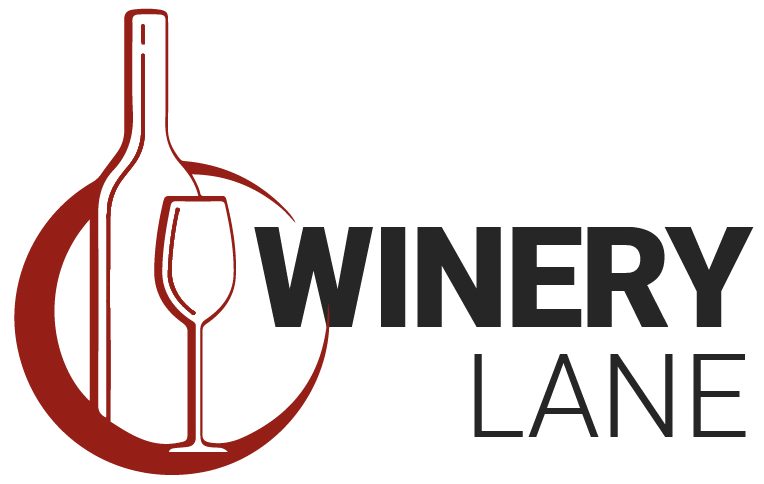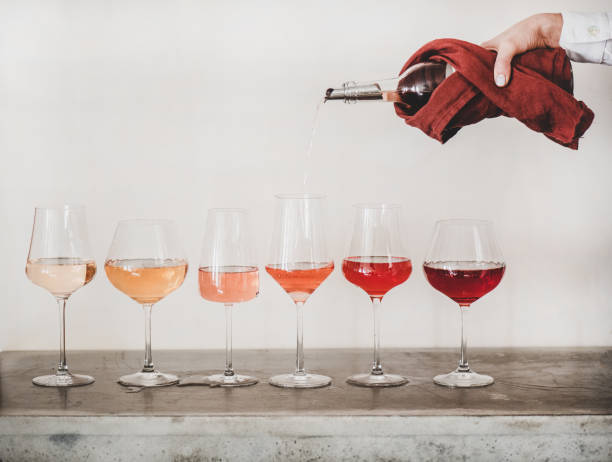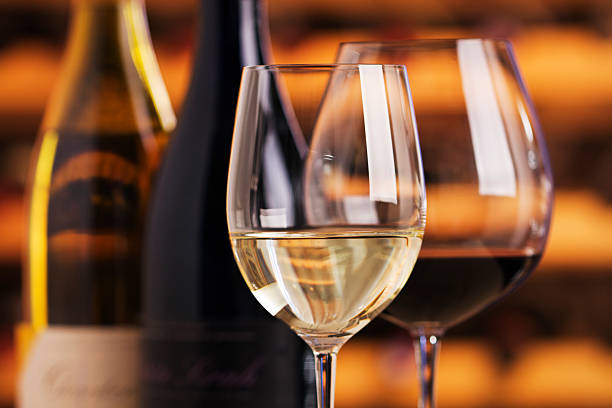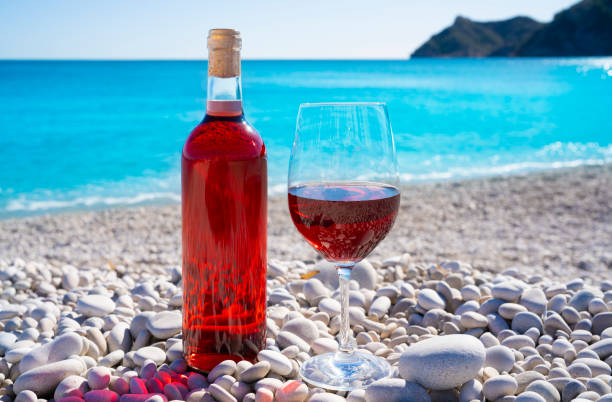Red Wine
There are many different types of glasses of red wine. However, each has a unique feature that enhances the wine’s taste. The red wine glasses have large openings and full bowls. This allows you to enjoy the aroma fully. This full-styled glass allows air to contact the wine’s surface, bringing out the complex flavors and aromas. This design also increases the rate of oxidation, which helps to smooth out the distinct tastes in red wines.
Bordeaux Glass
The Bordeaux glass is the tallest of all red wine glasses. It has a long stem, a wide bowl, and a large bowl. However, it’s not as big as other red wine glasses. The height of the Bordeaux glass allows ethanol to diffuse on the nose by creating distance between the wine and the mouth. The size of the glass allows for more oxygen to be absorbed by tannins. This contributes to the characteristic bitterness of red wine. The design of Bordeaux Glass directs the wine toward the back of your mouth, which minimizes tartness while maximizing the flavor spectrum.
Types of wine: heavy, full-bodied red wines with high tannins
- Bordeaux blends
- Petite Sirah
- Cabernet sauvignon, cabernet franc
- Malbec
Pinot Noir Glass
A wide bowl is what distinguishes a pinot-noir glass from a Burgundy. The wide bowl allows the wine to interact unhindered with the air, improving its flavor and aroma. The thin rim of the glass makes it easy to taste and drink the wine.
Light red wines
- Pinot noir
Burgundy Wine Glass
Burgundy glasses have a bowl that is larger than the Bordeaux glass and a narrower top. This design allows the drinker the ability to taste subtle flavors by directing the wine directly to the tip of the tongue. The wide bowl and thin rim make it easy to sip, while the thin edge allows for easy drinking.
Types of wine: lighter and more delicate red wines
- Beaujolais
- Red Burgundy
- Dolcetto
Cabernet Sauvignon Glass
It is not as tall as the Bordeaux glass, but it is still elevated. The wide bowl allows the wine to breathe. The rim thickness may vary, but the narrow mouth helps to enhance the smell of the wine.
Types of wine: Bold red wines
- Cabernet Sauvignon
Standard Red Wine Glasses
If you are unsure, a standard glass of red wine will enhance the flavor of any red wine. The small opening allows the wine to flow continuously onto the tongue rather than in one go. This unique design helps to soften the richness and spice of red wine.
Types of wine: Medium- to full-bodied, red wines without or with spicy components
- Zinfandel
- Shiraz
- Carignan
- Merlot
- Chianti
White Wine Glasses
White Wine Glasses are designed differently than other wine glasses. They focus more on preserving wine aromas rather than letting the wine breathe. The bowl of a white wine glass is smaller, U-shaped, and more upright than that of a red one. The glass shape not only enhances the aroma of the wine but also keeps the temperature cool. White wine glasses are given longer stems in order to prevent the warm hand temperature from affecting the wine’s temperature.
Chardonnay Wine Glass
The opening of a chardonnay glass is larger, which allows the wine to reach the sides and tip of the tongue. The palate can detect the sweetness in the wine. This wine glass is a good balance between aroma and taste. The bowl allows for just enough air to concentrate the scent, while the large opening helps balance the sweetness and acidity on the palate.
Full-bodied wines
- Chardonnay
- Semillon
- Viognier
Sauvignon Blanc Glass
A sauvignon blanc is a tall glass with a thin bowl. It’s perfect for floral and fruity white wines. The slender bowl and tall glass capture the delicate, nuanced floral and fruit scents in the wine. They direct the scents directly to the nose. A sauvignon blanc glass makes the tongue form a U shape, which helps the wine flow down the front palate and towards the center. The tasters will enjoy a smoother drink as they savor each wine’s flavor.
Types of wine: fruity or floral wines, light to medium-bodied wines
- Sauvignon blanc
- White Bordeaux
- Fume blanc
- Loire
Montrachet Glass
Montrachet glasses are designed to accommodate complex white wines, and their design reflects this. The large bowl of glass allows for the complex intricacies to interact with enough air and open the flavors. It also has a large mouth, which enables the drinker to the opportunity to enjoy the rich aromas. This opening also allows the wine to flow to the sides of the mouth, allowing the drinker to taste both acidic and sour flavors.
White wines with complex notes
- Montrachet
- White Burgundy
- Corton-Charlemagne
- Meursault
Riesling Glass
The Riesling glass is the smallest of all the white wine glasses. It has a small, round bowl that gets narrower towards the rim. The rim is smaller than the majority of wine glasses and guides the wine to the center or back of the mouth. This prevents the sweetness from overwhelming the drinker.
Sweet varieties of wine
- Riesling
- Zinfandel
- Sauvignon blanc
- Gruner Veltliner
Dessert Wine Glasses
Dessert wine is best served in glasses to bring out its sweetness and aroma. Dessert wine glasses tend to be smaller due to their high alcohol content, which is typical of drinks served after dinner. This design directs the wine towards the back and tip of the mouth, which will magnify its sweetness.
Port Wine Glass
The narrow mouth of a port wine glass reduces ethanol evaporation and concentrates aromas at the top. It has the small, characteristic shape of dessert wine glasses but is tall enough to allow the wine to be swirled to release its aromas. This shape is designed to allow the wine to flow slowly through the middle of the mouth. It will enable the palate to appreciate the sweetness without feeling overwhelmed.
Types of wine: Port or other dessert wines
Sherry Wine Glass
A sherry glass is also small due to its high alcohol content. The narrow rim of the glass prevents ethanol from leaving while still allowing easy sipping. The unique design of a Sherry Wine Glass directs the wine towards the back of your mouth, preventing the sweetness from overwhelming the palate.
Types of wine: Sherry, cordials, dessert wines
Rose Wine Glasses
Rose Wine Glasses were designed to bring out the unique flavors of rose wine. The lip of a rose wine glass is what matters most. Many have a diamond-shaped stem with a softer structure and a longer stem. If you’re drinking a mature or young rose wine, the best glass design is either a flared lip or tapered.
Flared Lip Rose Glass
The lip of a rose glass with a flared lip is ideal for young rose wines, as it brings out the crisp flavors. The long stem prevents the hand of the drinker from warming the wine beyond its perfect serving temperature. The flared lip will enhance the sweetness of wine by directing the wine to the tip and most sensitive taste buds.
Type of wine: young, crisp white or rose wine
Slight Taper Rose Glass
Choose a rose glass with a slight taper for mature rose wines. These glasses are characterized by a wide, short bowl that is rounded on the bottom. The top tapers off. This shape allows the aroma of wine to rise to the top.
Type of wine: mature full-bodied rose
Sparkling Wine Glasses
At elegant events and parties, we’ve seen Champagne in these tall glasses with a distinctive shape. This particular shape is not just for aesthetics but also plays an important role in enhancing sparkling wine and Champagne’s flavor. Sparkling wine glasses are usually narrow and upright. This helps to maintain the taste and carbonation of the wine.
Coupe Glass
A Coupe Glass is a glass with a distinctive shape. It has a shallow, wide bowl and a stem. This glass was popular in the 1920s for serving bubbly dessert Champagne made with heavy syrup dosage. This bowl is less popular today because it causes wine to be in contact with the air, which quickly dissipates aromas and bubbles. Coupe glasses are perfect for themed cocktail parties. They hold a small amount and allow for portion control.
Types of wine: Sparkling wine and cocktails
- Sweet Champagne
- Cava, Franciacorta
- Prosecco
Flute Wine Glass
A flute wineglass, which is often associated with Champagne or sparkling wine, is perfect for serving Champagne or sparkling wine. The stem is short to medium in length, and the bowl is long, narrow, and upright. The carbonation is retained, and the wine’s flavor is captured. The bead at its base also encourages bubbles that quickly rise and gather.
Types of wine: Young sparkling wine or Champagne
- Cava
- Franciacorta
- Prosecco
- Asti
Tulip Wine Glass
The name of this glass comes from its shape. It has a narrow bowl at the bottom that becomes wider in the middle and then gets smaller toward the opening. The little top keeps sparkling wine and Champagne from becoming flat while also sending aromas to the tongue rather than the nose. The base of the glass has a bead that makes bubbles rise. However, the width allows for a wide range of flavors to flourish.
Types of wine: Young or mature Champagne
- Cava
- Franciacorta
- Prosecco
- Asti




